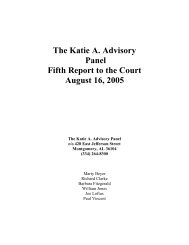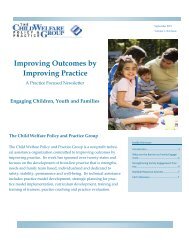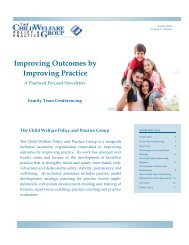How Computers Call The Shots For L – DCFS - Los Angeles County ...
How Computers Call The Shots For L – DCFS - Los Angeles County ...
How Computers Call The Shots For L – DCFS - Los Angeles County ...
You also want an ePaper? Increase the reach of your titles
YUMPU automatically turns print PDFs into web optimized ePapers that Google loves.
<strong>How</strong> computers call the shots for L.A.<br />
<strong>County</strong> children in peril<br />
Email Picture<br />
Robert Gauthier / <strong>Los</strong> <strong>Angeles</strong> Times<br />
Social worker Ladore Winzer, left, looks for a crack-addicted mother who reportedly failed a mandatory drug test, leaving her<br />
vulnerable to having her child removed. Audio slideshow<br />
Social workers feed in data on suspected abuse and neglect, and a decision pops out. Officials say the<br />
system eliminates the previous scattershot approach. Critics say the human element is slighted.<br />
By Garrett <strong>The</strong>rolf<br />
March 8, 2009<br />
<strong>The</strong>re's no time to wash away the smell of sour milk from the baby's skin, so the mother wipes the dozing<br />
infant's face with the filthy bib hanging from his neck. "WIC cares about me," it reads, a reference to the<br />
free food program for poor women and children.<br />
Social worker Ladore Winzer has just told the mother she will detain the 11-month-old boy and process<br />
him this night into foster care.<br />
It's after dusk and the slim, efficient social worker, late returning home to her own family, is stuck for now<br />
in the middle of this ghetto vista. Cars swerve around a lampshade; a graffiti tribute to a dead man runs<br />
across a cinder-block wall; a hunched homeless man pushes his cart across the grass-tufted sidewalk.<br />
"If I'm good, can I get my baby back in three months?" the mother asks, conjuring a weak smile in an<br />
attempt to seal the proposal.<br />
Chances are Winzer will not be making the decision.
A computer will.<br />
<strong>The</strong> process starts with a tip to <strong>Los</strong> <strong>Angeles</strong> <strong>County</strong>’s child abuse hotline. Over the course of a typical<br />
week, the Department of Children and Family Services receives 3,000 calls.<br />
Those that meet the legal threshold -- as determined by the computer and verified by a worker -- are<br />
routed to investigators like Winzer. <strong>The</strong> process is usually inaccessible to outsiders because of child<br />
confidentiality rules, but over four days <strong>The</strong> Times had the rare opportunity to witness it.<br />
Upstairs from the Hawthorne branch's stark waiting room, where a guard stands watch, the phone rings at<br />
Winzer's desk.<br />
A caller to the hotline has reported seeing three young children wearing torn clothing on the broken<br />
sidewalk outside a Popeye's chicken. Nearby, a colleague fields a report of a 7-month-old baby<br />
hospitalized after being sodomized. Another worker responds to an allegation that a young mother has<br />
abandoned her infant with her ex-boyfriend's parents.<br />
At their computer terminals, Winzer and her colleagues begin translating the allegations into answers that<br />
fit neatly into the multiple choice questions asked by the computer program called Structured Decision<br />
Making, or SDM.<br />
If a parent has a drug or alcohol problem, the computer adds one point to the score; no prior referrals<br />
subtracts a point. An allegation of excessive discipline, defined as "torture," adds another point.<br />
<strong>The</strong> system provides a series of questionnaires for different stages of an investigation.<br />
Social workers' answers to certain questions prompt action. In a safety assessment, for example, a<br />
caregiver found not to be supervising or feeding a child must be directed to immediate assistance;<br />
otherwise the computer requires that the child be detained.<br />
After about two dozen entries on the risk assessment questionnaire, the computer kicks back a level of<br />
risk: low, moderate, high or very high.<br />
Critics say SDM mechanizes a decision-making process that only human beings can fully comprehend.<br />
<strong>The</strong> questionnaires, they argue, fail to take full advantage of social workers' experience and intuition.<br />
Others -- including many who use SDM on a daily basis -- say it provides objectivity in answering key<br />
questions where there once was subjectivity:<br />
Should a parent be investigated for abuse or neglect? Should a child be removed from the home? Should<br />
a child ultimately be reunited with his or her parents?<br />
As a case moves from one point to the next, the answers to SDM's questionnaires build a complete
dossier. Because <strong>Los</strong> <strong>Angeles</strong> <strong>County</strong>'s child protection system works like an assembly line, no single<br />
person follows a case from beginning to end; only the computer does.<br />
Although humans can overrule the computer, SDM's call has stood in 91% of decisions in the county on<br />
whether to open an investigation, 92% of recommendations on removing a child from a home and 99% of<br />
decisions on whether to return a child.<br />
<strong>The</strong>re is evidence that favoring math over emotion works.<br />
Studies show that actuarial statistics used by SDM predict the likelihood that a child will be abused or<br />
neglected with a precision never obtained when humans made decisions on their own.<br />
But SDM is only as good as the information humans enter into it.<br />
Since it went into widespread use in <strong>Los</strong> <strong>Angeles</strong> <strong>County</strong> seven years ago, there have still been high-<br />
profile cases of children left in abusive households.<br />
"If the social workers don't do their investigation properly, if they don't analyze the case thoroughly, it will<br />
be garbage in and garbage out," said Trish Ploehn, director of the family services department.<br />
Hope for a good outcome<br />
In a conference room at the Hawthorne office, veteran social worker Wendy Luke seems full of hope.<br />
"I think you really want to do whatever it takes," she tells a mother whose four children have been in foster<br />
care for weeks.<br />
<strong>The</strong> children -- three boys and a girl ages 4 to 10 -- were removed from the mother's care after a police<br />
officer responded to a prank 911 call and found them home alone, wrestling in their underwear. One had<br />
burned another with a spatula while trying to fry an egg. None went to school.<br />
According to SDM criteria, the home was unsafe and the children had to be removed. Now, Luke is<br />
working to resolve the safety issues identified on the computer questionnaires.<br />
To get her children back, the mother needs to reduce her risk factors from high to moderate on SDM's<br />
scoring system.<br />
<strong>The</strong> mother, estranged from the violent, alcoholic father, says she is overwhelmed working as a grocery<br />
cashier from 7 a.m. to 3 p.m. with no help. Luke asks her to name her strength as a parent.<br />
"<strong>The</strong> only strength I see right now is me wanting to get my kids back," she says, adding that she made
limited calls to her children's foster homes because it was too upsetting to be apart.<br />
What was her plan to reunite her family?<br />
"I have no idea how to answer that. <strong>The</strong> best plan is. . . . I have no idea," the mother says, releasing the<br />
words into the air slowly. "If I answered you as a mother, I would say I want them back right now. But it<br />
would be the same, with no one to watch my kids. I can say that everything will be fine, but I would be<br />
lying."<br />
Luke and her teammates offer the woman assistance getting on waiting lists for child care and mental<br />
health counseling.<br />
Although her SDM score was hurt by a previously substantiated case of neglect, she can reduce her<br />
points if she can show that she is sober. Luke tells her that if she complies with parenting classes and<br />
random drug and alcohol testing, she can be reunited with her children within 180 days of their removal.<br />
<strong>The</strong> mother, with big hoop earrings, stark eye makeup and a hardened and weary disposition, writes it all<br />
down on a napkin.<br />
An attempt to do better<br />
Not long ago, the decision about whether to investigate a case and whether to remove or return a child<br />
was left almost entirely to social workers.<br />
<strong>The</strong> result, the family services department determined, was standards that were applied scattershot.<br />
Choices could be improperly influenced by individual experience and unconscious bias. Even the best<br />
decisions were often backed up by sparsely written case reports, sometimes just a paragraph long.<br />
"We would get cases of detained children and not be able to understand why the social worker made the<br />
decision they did," said Michael Nash, the presiding judge of the county's children's court system.<br />
In the worst cases, social workers failed to remove children from homes where they were later killed.<br />
Even as some children died, the department suspected that too many others were detained. A small city<br />
lived in foster care, population 52,135 in 1997.<br />
But how would the county do better? <strong>The</strong> work would have to be done with the same corps of social<br />
workers whose low pay, low level of experience and high turnover rate were blamed for many of the<br />
department's shortcomings.<br />
A social worker starts at $35,200 a year; among those out investigating in the field, two-thirds have fewer<br />
than five years' experience with the department; 7% of the department's 3,700 social workers quit each
year.<br />
In 1999, social workers at the Santa Fe Springs office began using SDM to score families' risk. <strong>The</strong><br />
system was expanded department-wide in 2002. <strong>The</strong> number of children in foster care is now about<br />
21,000.<br />
A system supporter<br />
Winzer embraces SDM under the belief that it provides her a solid basis to navigate unfamiliar<br />
circumstances, often colored by differences in race, class and sensibilities. But she knows the system,<br />
which is used in areas across the nation, is prone to manipulation.<br />
An anonymous tip underscores this issue. <strong>The</strong> allegation? A young girl had been sexually assaulted by<br />
her mother's boyfriend. It's the third time the allegation has been received in as many months, and the girl<br />
must be examined by a doctor again. <strong>The</strong> accusation is related as if it were an eyewitness account, yet it<br />
provides an address for the mother and daughter that is long outdated.<br />
As Winzer listens over the phone from her bare cubicle, the mother explains that she believes the<br />
anonymous tipster is her estranged husband who is angry about her new boyfriend.<br />
"I know, ma'am. <strong>The</strong>re is nothing I can do," Winzer says.<br />
<strong>The</strong> girl is already classified because of additional factors as being at "high risk" for abuse and is in<br />
jeopardy of being placed in foster care. Now she must undergo an intrusive and time-consuming medical<br />
examination.<br />
Winzer hangs up the phone. "She's tripping," Winzer tells the social worker in the next cubicle, "because<br />
this is a totally bogus referral. You know this is the husband trying to put this on the new boyfriend."<br />
Another major question is why investigations involving black children result in detentions four times more<br />
often than investigations of white children. Although a racial disparity existed before the switch to SDM,<br />
Department of Children and Family Services officials had hoped it would be mitigated by the computer.<br />
Instead, the disparity has worsened slightly over the course of SDM's use.<br />
Now suspicion is centering on the system's use of factors that may disadvantage black families. <strong>For</strong><br />
example, SDM counts prior referrals against a parent even if they are not substantiated, though<br />
substantiated referrals have greater weight. Studies show that black families are more likely to be the<br />
subject of referrals, perhaps because of bias and because they more often come into contact with<br />
mandated reporters such as social service workers and police.
Richard Wexler, executive director of the National Coalition for Child Protection Reform, said that SDM<br />
presents the "veneer of objectivity" but that the use of previous referrals is a "self-reinforcing" mechanism<br />
that unfairly raises risk scores.<br />
Raelene Freitag, director of the Children's Research Council, the organization that developed Structured<br />
Decision Making, defends the inclusion of earlier referrals as appropriate. <strong>The</strong> continued racial disparity,<br />
she says, may have more to do with unequal access to the programs that help families stay together than<br />
bias in SDM.<br />
Backed by computer<br />
It's midafternoon when Winzer sets out to investigate a priority call. A tip has come in that the mother of<br />
an 11-month-old boy is using drugs again.<br />
A Compton native, Winzer had wanted to be a police officer, but her mother vetoed the plan. Social work<br />
seemed similar in many ways.<br />
<strong>The</strong> door is open to the mother's apartment, so Winzer knocks on the wall. "Hello," she calls out, "this is<br />
Children's Services. Ms. Winzer."<br />
<strong>The</strong> 40-year-old mother, Darlene, emerges from the apartment in a T-shirt from her faith-based drug<br />
treatment program and greets Winzer with an open smile. <strong>The</strong> apartment is sparely furnished with a<br />
couch, a mattress on the floor, a playpen doubling as a crib and a bicycle with a flat tire. <strong>The</strong> floor is<br />
strewn with compact discs.<br />
Winzer's posture has stiffened, as she steels herself for an investigation that may end badly. <strong>The</strong><br />
computer program's analysis will count points against Darlene because the family services department<br />
has already removed 3- and 15-year-old children from her care. <strong>The</strong> points will rise further because she<br />
has been the subject of 13 referrals to the child abuse hotline since 1999.<br />
This might not have mattered if the mother had not told a counselor at her drug treatment program that<br />
she had relapsed.<br />
Revealing a certain lack of guile, she tells the story again to Winzer. Over the course of an all-night jag<br />
the previous weekend, she says, she smoked up to 15 rocks of crack cocaine and swallowed a handful of<br />
sleeping pills. <strong>The</strong> baby was with a friend, she says. "My whole life is designed around not using, and I<br />
used," she says.<br />
Winzer asks for information to contact the baby's father, but Darlene is not even able to provide a full<br />
name. "His name is Kevin, as far as I know. He goes by so many names," she says.<br />
Winzer consults with the office and agrees with supervisors that the mother's Structured Decision Making
score is now through the roof. <strong>The</strong> social worker confides to a reporter that she's thankful to have the<br />
computer program's process backing up her assessment, making sure that all factors are considered.<br />
Fifteen minutes later, she is strapping the baby into a child seat in the back seat of her truck. <strong>The</strong> mother<br />
sits on the couch, her head in her lap, her body heaving in sobs.<br />
Because of the boy's young age, two processes begin simultaneously: one to reunite him with his mother;<br />
one to find a permanent adoptive family. <strong>The</strong> outcome will be heavily influenced by how well the mother is<br />
able to improve her SDM score.<br />
Before the social worker leaves, Darlene says her Section 8 housing and welfare assistance is largely<br />
dependent on her ability to retain custody. "You don't know when I will get my child back?" she asks again.<br />
"That all depends on you," Winzer tells her.
On the trail of a mother accused of neglect<br />
Email Picture<br />
Robert Gauthier / <strong>Los</strong> <strong>Angeles</strong> Times<br />
Veteran social worker Wendy Luke works the phone at her Hawthorne office as she investigates a case.<br />
A veteran social worker must search for the mother, assess relatives' claims and deal with a computer glitch<br />
in the case of two young children. <strong>The</strong> computer program supports the worker's decision.<br />
By Garrett <strong>The</strong>rolf<br />
March 8, 2009<br />
Wendy Luke wakes at 5 a.m., prepares Cream of Wheat for breakfast, as well as a dinner of barbecue<br />
chicken, macaroni and cheese and green beans for her husband and two young children.<br />
Luke, a veteran social worker who supervises eight less-experienced colleagues, knows it could be a long<br />
day. Her name is first on the list for investigations that require a response within 24 hours.<br />
By 8:30 a.m. she is in the office, at times holding a phone to each ear to offer guidance to colleagues in<br />
the field.<br />
Shortly after 5 p.m., just when it looks as though she will be able to leave on time, another referral drops.<br />
As with each of the 3,000 tips that come in each week to <strong>Los</strong> <strong>Angeles</strong> <strong>County</strong>'s Department of Children<br />
and Family Services, the case will be evaluated at each step by the department's risk assessment<br />
computer program, known as Structured Decision Making, or SDM.<br />
A child abuse hotline worker reports to Luke that a young mother has allegedly abandoned her children, 6<br />
months and 2 years, with relatives. A possible address for the mother was given.<br />
<strong>The</strong> paternal grandparents of the 6-month-old, who have the baby in their care, reported the alleged
neglect and left their address as well. Because of the age of the child and some of the allegations, SDM<br />
determined that the case was high priority.<br />
Luke gets in her car to begin her investigation. She heads out without a portable version of SDM that<br />
social workers are supposed to be using on site. She and her colleagues have not yet been trained on the<br />
system. <strong>The</strong>re's another problem too: <strong>The</strong> office computers have been malfunctioning, so it's unlikely she<br />
will be able to call in and ask a co-worker to put the information into the questionnaires.<br />
But Luke has become expert at assessing SDM's scores even without the computer.<br />
<strong>The</strong> mother's apartment is on the second floor of a dilapidated building. Luke knocks, summoning the<br />
voice of a man who speaks to her through the metal screen door. He says that the teenage mother rents<br />
a room in the apartment but that he hasn't seen her for days. Luke leaves her phone number.<br />
She moves on to the grandparents' home in a comfortable middle-class neighborhood. An elderly man,<br />
with a slumped posture and concave chest, answers. He's trembling. His wife, wearing a tight T-shirt<br />
reading "Little Miss Lucky," stays in the background.<br />
All three gather around the dinner table, and the grandfather gives Luke his account, nervously fingering<br />
notes scrawled on each side of sheets from a small notepad.<br />
He says the mother left the child several days earlier after cryptically explaining that she needed to go to<br />
the hospital for a procedure. After two days passed with no word from her, the couple came to doubt her<br />
story. <strong>The</strong>y called hospitals but found no record of her.<br />
<strong>The</strong> next day, the mother returned, but they refused to give her the child without proof that she had been<br />
hospitalized.<br />
<strong>The</strong> grandfather's story gives Luke key background information, but the allegations don't fit neatly into<br />
SDM's questionnaire. He says his son, imprisoned for domestic violence against the child's mother, is not<br />
sure that he is the baby's biological father. <strong>The</strong> grandfather also tells Luke that the baby's mother is in<br />
treatment for methamphetamine use. If the information is true, Luke believes the factors will probably<br />
elevate the assessment of the child's risk of abuse or neglect.<br />
But without the mother present, there is no way for Luke to substantiate the grandfather's claims.<br />
<strong>The</strong> grandparents can offer no address where the baby's 2-year-old sibling might be found, so Luke<br />
cannot immediately assess that child's well-being.<br />
Because the computers aren't working, she estimates SDM's score based on memory and experience.<br />
She considers her suspicion that the grandparents may be trying to retaliate against the mother for their<br />
son's imprisonment.
She decides to leave the child unofficially in their care. She wants to give the investigation time to develop.<br />
If the mother does not call Luke within 48 hours, she tells the grandparents, she will probably detain the<br />
6-month-old and possibly put the child officially in their care. Luke knows that if the mother fails to turn up,<br />
she can cut off the mother's welfare check, one of the surest ways to get an elusive parent to resurface.<br />
Despite Luke's persistent efforts over the next several days, it takes the mother nearly a week to make<br />
contact.<br />
In person, the mother appears young and irresponsible, but there are no grounds to remove her children.<br />
She recovers the baby from the grandparents.<br />
SDM's questionnaires affirm the decision. <strong>The</strong> program assesses the risk to her children as "moderate."<br />
<strong>The</strong> score conforms with the choices Luke has made.
















